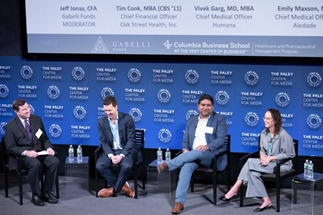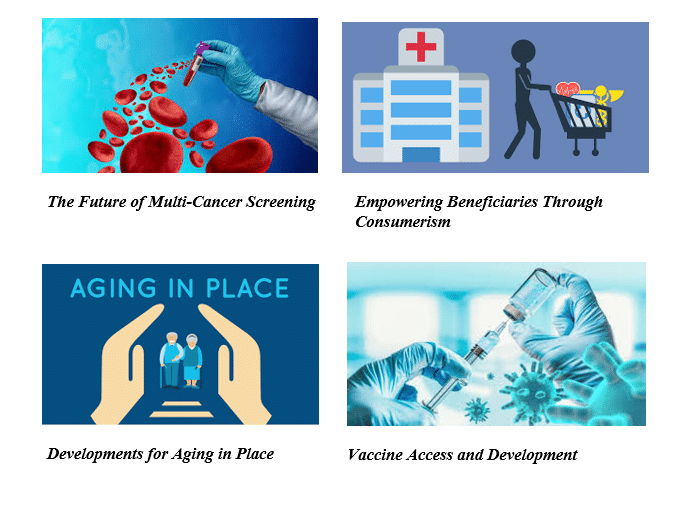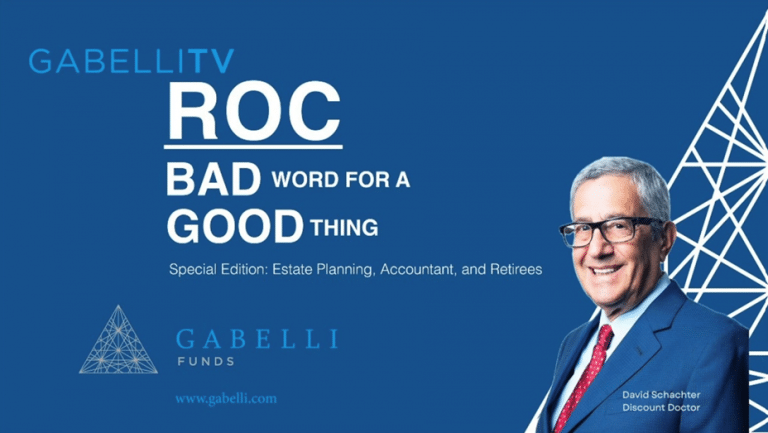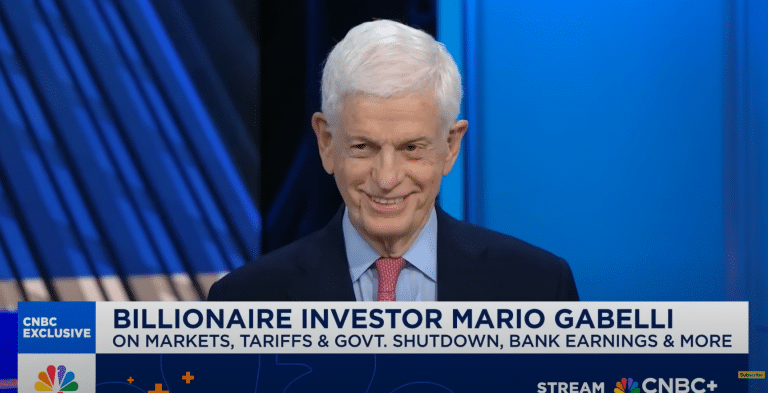5th Annual
Gabelli Funds
In Conjunction With Columbia Business School
Healthcare Symposium

Panel 1: Reimagining Primary Care

Panel 2: Trends in Regenerative Medicine

Panel 3: The Future of Medicare Advantage
5th Annual Gabelli Funds – Columbia Business School Healthcare Symposium
November 17, 2023
Gabelli Funds and Columbia Business School co-hosted the 5th Annual Healthcare Symposium on November 17th. The symposium addressed the changing nature of primary care, advances in regenerative medicine, and the future of the Medicare Advantage program. The panelists consisted of senior executives from both public and private healthcare companies.
Conference Agenda
Welcome
· Jeff Jonas, CFA, Gabelli Funds
· Carri Chan, Director, Healthcare and Pharmaceutical Management Program, Columbia Business School
Panel 1. Reimagining Primary Care
Jeff Jonas, CFA, Portfolio Manager, Gabelli Funds – Moderator
Panelists
· Tim Cook, Chief Financial Officer, Oak Street Health
· Vivek Garg, MD, Chief Medical Officer & Senior VP, Primary Care at Humana
· Emily Maxson, MD, Chief Medical Officer, Aledade
Panel 2. Trends in Regenerative Medicine
· Sara Wojda, Research Analyst, Gabelli Funds – Moderator
Panelists
· Stuart Hart, MD, Chief Medical Officer, Integra Lifesciences
· Sonya Herrick, Vice President, Biologics and Biomaterials, Johnson & Johnson
· Scott Rodeo, MD, Head of Regenerative Medicine, Hospital for Special Surgery
· Nina Tandon, Chief Executive Officer and Founder, Epibone
Panel 3. The Future of Medicare Advantage
Daniel Barasa, Research Analyst, Gabelli Funds – Moderator
Panelists
· Emme Deland, Senior Vice President, Strategy, Dalio Center for Health Justice
· Amy Mulderry, Chief Development Officer and Carelon Chief Financial Officer, Elevance
· Jessica Son, MD, Chief Medical Officer, Clover Home Care
· Pat Wang, Chief Executive Officer, Healthfirst
TAKEAWAYS FROM THE CONFERENCE
Panel 1 – Reimagining Primary Care
· Changing the Practice of Medicine: New, well capitalized chains of primary care clinics are changing the way primary care medicine is practiced. By investing more time and money in primary care and preventative medicine, payors can actually save money by catching disease early and avoiding high cost hospitalizations and surgeries down the road. This involves identifying high risk patients and seeing them as often as every month for longer, more comprehensive visits. It involves a team of caregivers with strong administrative support to maximize the patient’s health and the time physicians get to spend with them.
· Medicare Driving Change: Medicare has helped drive many of the changes we are seeing in primary care through multiple risk sharing programs. Primary care physicians can take limited upside/downside risk based on their ability to lower health care costs, and they can eventually move to a capitation model with full cost responsibility. These programs better align the interests of both payors and providers, versus the traditional fee-for-service model that only rewards more utilization.
· Staffing Shortages: While the labor market is still extremely tight for doctors and nurses, none of the companies are having significant problems hiring. Many physicians prefer these new clinic models, getting to spend more time with their patients and less time on administrative tasks. They are typically paid a base salary plus a bonus of up to 20% based on a range of clinical quality and patient satisfaction metrics.
· Telemedicine: While telemedicine surged in popularity during the COVID-19 pandemic, it has declined back to about 10% of visits. Technology and broadband access can be issues in rural and underserved areas. Physicians and patients often disclose and discover more health issues in face to face interactions.
· Electronic Health Records: They are a necessary part of medicine, but they are still not user friendly enough for the physician. Companies layer on additional systems to identify high risk patients, close gaps in care, and create a more proactive, preventative care environment. It is important to select the most impactful metrics to share with physicians to avoid data overload.
· Investment: A typical Oak Street clinic is about 10,000 square feet and costs $2 million to build out. It takes up to three years to break even and seven to eight years to reach full profitability. With 5,000 patients at full capacity, a clinic could generate $8 million in annual gross profit dollars. This level of scale and capital is a huge advantage versus independent primary care physicians who typically have just a couple months of working capital on hand.
· Emerging Threats: Amazon, Walmart, and others have publicly announced healthcare expansion plans. Amazon’s One Medical network of clinics are taking a concierge medicine approach for now, and previous efforts to disrupt mail order pharmacy and telemedicine have had limited success. The industry is evolving rapidly on its own to be more responsive and customer friendly, but most physicians are consolidating into larger practices and networks.
Panel 2 – Trends in Regenerative Medicine
· US Positioning:The US is aware and proud of its strict regulation, which engenders trust in the related population. Without such strict guidelines, there could be a slippery bioethical slope, where patients could be risking their health by false information. The idea of indiscriminate use is common if patients look outside the US for more risky or attractive solutions. In terms of other countries that are on the right path, the Asia-Pacific region tends to have highly regulated environments that foster entrepreneurship. In general, professionals in US do not commend “fly by night” clinics that pop up worldwide, because even though they fuel demand, they could be detrimental to the overall reputation of the space.
· Scaling and Patient Access: To address widespread patient access, regenerative medicine requires investment and evidence. The solutions need to show efficacy, and this also requires scale and manufacturing. Regenerative medicine scales up via clinical studies, because it needs to show evidence that it works. For now, regulation is piecemeal, but hopefully, will be regulated on more of a platform framework in the future. Scaling up would allow for lower costs, which would ultimately lead to improved affordability for everyone.
· Patents and IP:Patents are the currencies of biotech, and companies are very proud of their IP, which drives innovation. IP in regenerative medicine is different from other parts of healthcare, as the patent is around the process to get to the final product, where the method of production matters most. Companies would not go through this complex and costly pathway without the proper IP protection. The costs of running trials in all the major markets (i.e. US, Europe, China) are high, not to mention China potentially requiring local manufacturing. Given the years necessary for R&D, approval, and manufacturing, patents remain an extremely important framework in the development process.
· Regulatory Hurdles: In a sense, regulatory approvals and evidence are similar to the “chicken and the egg” idea. Researchers generate evidence and need to prove that it works and is reproducible. The process starts with the patient and customer needs. Regenerative medicine oftentimes yields better safety profiles than what is on the market today. By showing evidence that the device is safe and accurate, it can show that the efficacy is as good as or better than the market. By proving quantifiable outcomes, regenerative medicine can demonstrate it improves long-term quality of life.
· Reimbursement:Payors need to think about what costs are avoided or reduced if regenerative medicine is successful, such as surgical time, recovery time, readmittance, or revision surgery. Payors are open to the argument of value-based care, as standard devices are expensive, and the use of them can be reduced. Regenerative medicine can last a lifetime, while an implant will wear out over time. Payors generally care about the clinical evidence and the right kind of study and endpoint. Surgeons are open, curious, and willing to try regenerative medicine, but need the evidence.
· Patient Feedback: Some patients actively seek regenerative medicine. This could either be in the US where regulation is quite strict, or abroad where looser regulation allows for more risky treatments. Because of this, patients can be at risk of injury or infection. On the positive side, patients’ lives can completely change for the better with regenerative medicine. There are many unmet disease states where regenerative medicine can speed up the healing process, reducing the need for dependencies such as painkillers or costly assistance.
· Ethical Considerations: Patients are influenced by direct-to-consumer marketing to use many types of therapies, some of which can be detrimental to health if not safe or administered poorly. Another consideration is the use of stem cells derived from amniotic fluids and umbilical cords, which can now only be used under clinical trials. There is more scrutiny in terms of stem cell clinics. Companies like EpiBone use stem cells, but as an active ingredient. What is actually reinjected into the patient is not stem cells, but the product innovated from them.
Panel 3 – The Future of Medicare Advantage
· Sustainability of Medicare: The US currently spends ~$1 trillion on Medicare. CMS actuaries project that Medicare-related spending will grow to ~$1.8 trillion in 2031. The program has grown into a public-private partnership as the share of Medicare Advantage (i.e., plans administered by private insurance companies) has grown from ~19% in 2007 to ~50% today. The integration of Medicare Advantage, Medicaid and Long-Term Care could play a critical role in eliminating waste in the system, and enhancing sustainability of the program, especially as the demographics of eligible individuals skew even older.
· Aging Demographics: The demographic profile of Medicare eligible individuals is expected to skew older going forward. Over the next 10 years, seniors aged 75 and up are projected to grow as a proportion of all seniors. These beneficiaries tend to have more chronic conditions and higher medical costs. Panelists discussed different ways the industry is preparing to address additional costs from a much older membership mix, as people live longer with more chronic conditions. Top priorities include the remodeling of facilities to be elder accessible, higher use of telehealth and a shift of site of care into the home.
· Telehealth and Care at Home: Members shopping for Medicare Advantage plans have expressed great interest in home care. Several payors including large insurers UnitedHealth and CVS, as well as smaller players such as Clover Health, have invested significant resources into care at home, enabling them to potentially shift away from more costly settings such as hospitals. Presence in the home also allows payors to address various social determinants of health (SDOH) such as isolation/loneliness, transportation challenges to doctor appointments, or food insecurity. In a recently published study by Brigham Young University, socially isolated people were found to be 50% more likely to die prematurely. Clover has local care teams to assess members’ homes, living situation, presence of caregivers (similar aged/health spouse), and transportation needs.
· Complexity in Navigating Available Benefits: Members enrolled in Medicare Advantage are typically attracted to lower costs and enhanced benefits such as dental care, hearing aids, and nonmedical benefits like transportation and home-delivered meals. One of the biggest concerns related to the program is that beneficiaries find it difficult to choose the best plan given the large number of factors such as in-network vs out-of-network facilities/providers, prescription drug formularies, and cost-sharing options. Finding a great Primary Care Physician (PCP) will be key to understanding the best choice for each individual. Moving away from a fee-for-service (FFS) reimbursement model that is squeezing out PCPs to value-based care models will be key.
· GLP-1s and Alzheimer’s Drugs: Excitement continues to build around 2 classes of drugs that could have profound impact on seniors – Alzheimer’s drugs and GLP-1s. However, the high costs of these drugs remain prohibitive and could lead to lack of access. Focus should be on transitioning reimbursement models to be contingent on the value that the drugs have. Value-based care is, however, still in its infancy. Providers also highlight pre-authorizations and inclusion/exclusion criteria in formularies as challenges that the industry needs to address. Coverage for Alzheimer’s is expected to ramp up very slowly.
· Use of AI and Predictive Analytics: Providers and insurance companies are currently using predictive analytics to empower doctors at the point of care by identifying high risk patients that may need intervention in order to catch problems early. Artificial intelligence is also expected to be used to improve productivity by helping lower skilled/cheaper labor perform higher value tasks.
Jeff Jonas, CFA Sara Wojda Daniel Barasa
(914) 921-5072 (914) 457-1066 (914) 921-5083
jjonas@gabelli.com swojda@gabelli.com dbarasa@gabelli.com
©Gabelli Funds 2023
ONE CORPORATE CENTER RYE, NY 10580 Gabelli Funds TEL (914) 921-5000 Fax 914-921-5098









